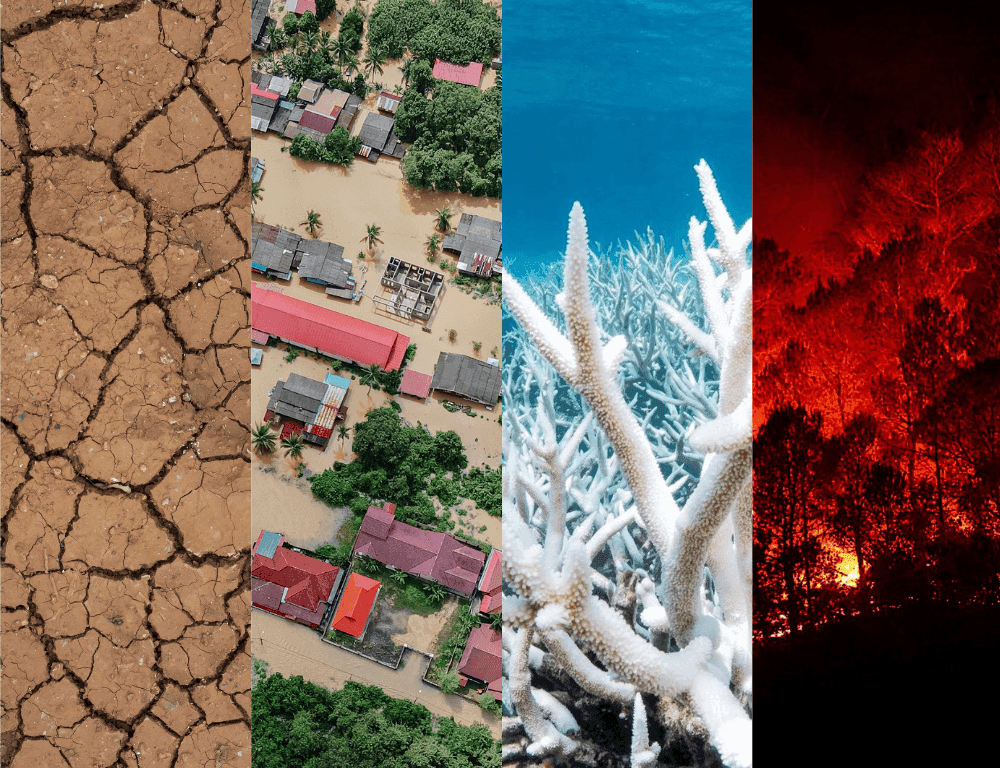Climate Change
Climate Change and How does it Impact You

Have you ever felt that summers are getting hotter and the winters are getting colder. You are right, you may have just witnessed the effects of Climate Change. Climate change has wreaked havoc throughout the world: Erratic weather patterns, floods, droughts, melting polar caps, storms etc.
What is Climate Change?
Climate change is the long-term change in temperatures and weather patterns. The earth has in the past experienced extreme temperature changes in the past 650,000 years, 7 cycles of glacial advance and retreat. The last ice age occurred 11,700 years ago. These ice ages have been attributed to miniscule orbital changes of the earth, but the temperature changes we have witnessed in the past few decades are too large in too short a period of time to be attributed to orbital changes.
Since the industrial revolution in the 1800s, the average global surface temperature has increased by 1.1 degree Celsius and the Arctic has been warmed by 3.2 degree Celsius. The increase in Surface Temperature masks the true scale of climate change, since the ocean absorbs 90% of the heat trapped by green house gases. The ocean has absorbed as much heat between 1997 and 2015 as it did in the previous 130 years. The main driver of climate change is primarily due to burning fossil fuels like coal, oil and gas. The burning of these fossil fuels generate greenhouse gas emissions, which act like a blanket wrapped around the earth, this traps the sun’s heat and raises temperatures.
How does climate change affect you?
There are multiple observable changes that you can see around you: changes in rainfall resulting in floods and droughts, intense heat waves, warmer oceans, acidic oceans resulting in coral bleaching, melting ice caps and rising sea levels.
Climate Change impacts your health, environment and economy:
1) Higher temperatures increase the duration, intensity and frequency of heat waves which can cause health risks.
2) Worse air and water quality can increase the spread of certain diseases.
3) Rising sea levels threaten coastal communities and ecosystems. Eg: the small island nation of Tuvalu, with a highest elevation of 3m is currently under the threat of sinking. It is predicted that the island would be totally submerged in the next 100 years.
4) Changing patterns in rainfall, affect water quality, can cause water scarcity, floods and droughts. This can lead to loss of property, cause displace masses and lead to acute food shortage.
5) Changing ecosystems influence plants and animal species and the timing of their lifecycle events. These changes have been observed all over the world. In recent decades, almond trees in Spain have been blooming early, sometimes even a month earlier than usual. The beautiful almond blossoms signify the beginning of spring, the start of flowering depends on temperatures. Before winter sets in the pores close to protect themselves against winter and the tree is dormant. The fruit grows only after the temperature rises. But, since the almond trees are blooming earlier, the highly sensitive fruits can’t bear the temperature changes, leading to the massive losses for the farmers.

What can you do to battle climate change?
Each and everyone of you can help limit climate change, from your travel, to electricity, to the food we eat, to our buying patterns. In 2020, India had 2.4 tonnes of CO2 equivalent per person, the global average of CO2 equivalent per person was 6.3 tonnes. To preserve our planet and maintain a livable climate the average emissions need to be brought down to 2.5 tonnes by 2030. Here are some of the things you can do.
Save Energy at Home
Most of the electricity we use is powered by coal oil or gas. By using electricity economically you can reduce your carbon footprint by up to 900 kg per year.
Walk, bike or take public transport
Our roads are jam packed with vehicles, most of them burning fossil fuels. You can consider walking or riding a bicycle for shorter distances and for longer distances consider taking trains or buses, or carpooling when possible. According to the UN, living car free can reduce your carbon footprint by up to 2 tons.
Eat more vegetables
Surprisingly eating a predominantly vegetable based diet can reduce your environmental impact. Producing plant based foods generally results in lower greenhouse emissions. Switching to a vegetarian diet can reduce your carbon footprint by up to 500 kg every year and for a vegan diet up to 900 kg.
Throw away less food
Throwing away food leads to the wastage of resources and energy that are used to grow, package and transport it, you are also losing out on the opportunity to utilize those resources. In addition when food rots in a landfill it produces methane, a greenhouse gas. It is recommended that you utilize the food you buy to the maximum and compost any leftovers. In doing so you can reduce your carbon footprint up to 300 kg per year.
Reduce Reuse Repair and Recycle
Any product that you buy has caused carbon emissions at each point in its production. Hence to reduce your emissions, buy fewer products, repair what you can, buy second hand and recycle.
Switch to greener sources of energy
The electricity you consume at home, commercial or industrial establishments comes from oil, coal or gas. Switching to greener sources of energy, like solar energy, where you can generate power from your very own rooftop.

Switch to an electric vehicle
If you are planning to buy a car, go electric. In recent years the price of electric cars are going down, and more and more people are switching to electric cars. Electric cars help in reducing air pollution and cause lower greenhouse emissions than fossil fuel powered cars. Switching to an electric car can reduce your carbon footprint by up to 2 tonnes every year.